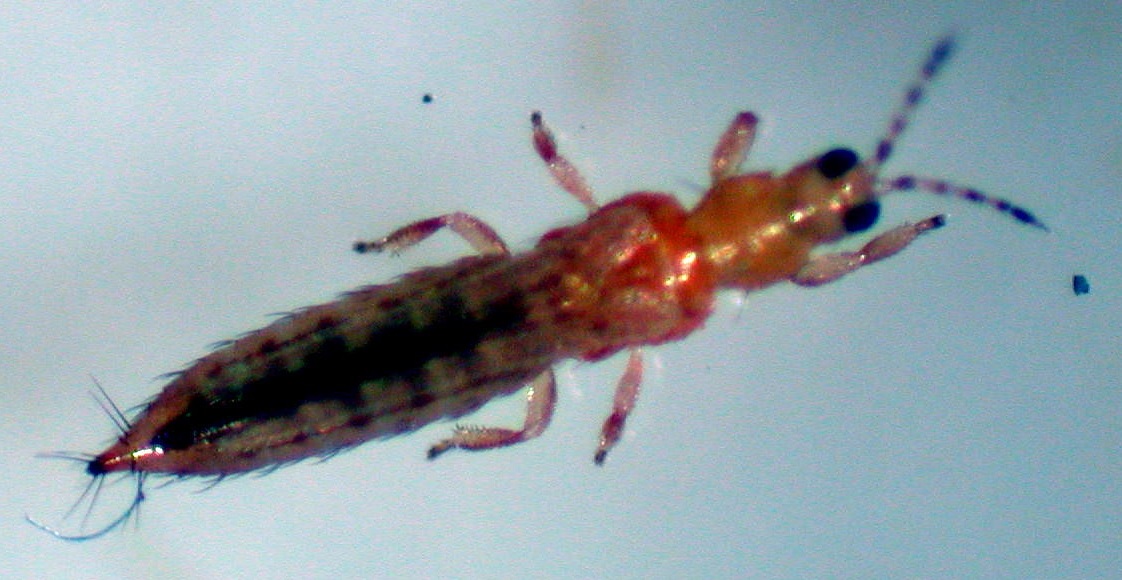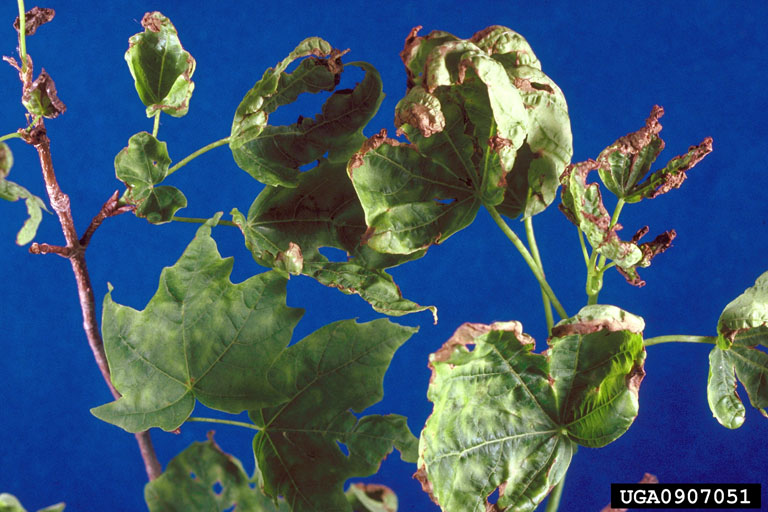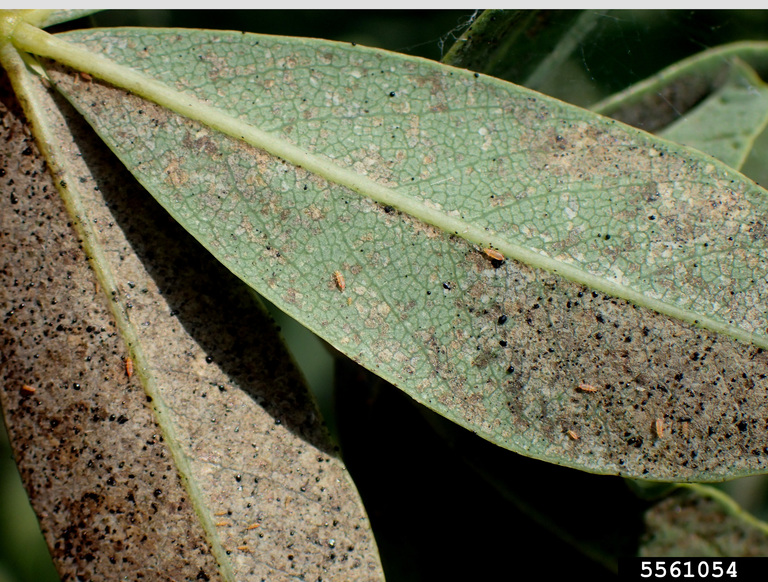 Recognizing and Managing Thrips - May 22, 2019 Jeff Schalau, Agent, Agriculture & Natural Resources University of Arizona Cooperative Extension, Yavapai County Every spring, thrips colonize a broad range of garden and landscape plants. Most damage occurs on deciduous fruit trees, where pears, plums and apricots seem most affected along with tender vegetable transplants. Thrips are very small insects and identification often requires a magnifying glass to see. Their damage often appears as scarred or distorted leaves, flowers, and fruit. The damage varies widely depending on the host plant and its stage of development. A single insect is called a “thrips” and multiple insects would be called some “thrips”. There is no such thing as a “thrip”. Thrips are in the order Thysanoptera which means “fringed wing”. Adult thrips are slender, less than 1/20 inch long, have long fringes on the margins of both sets of their long, narrow wings, and are often yellowish or blackish and shiny. Immature thrips (nymphs) are similarly shaped with a long abdomen but lack fully developed wings and most species are translucent white to yellowish. When disturbed, many species of thrips will curve the tip of their abdomen upwards. Common pest thrips include the western flower thrips which feeds on vegetables, grapes, deciduous fruit trees, strawberries, raspberries and herbaceous plants; the onion thrips and the bean thrips feed on vegetables; the citrus thrips which feeds on citrus and pomegranate. All of these thrips look similar to the untrained eye and require close inspection (usually by an entomologist) to positively determine species. The best way to check for their presence is to hold a flower, stem, or branch tip and tap it sharply against a clean, white sheet of paper. You don’t need to cut the branch off the plant. Look closely at the paper. If thrips are present, you will see tiny linear bodies that are moving around. Using magnification, you may see mostly wingless nymphs and possibly a few winged adults crawling around on the paper. Many species of thrips feed within buds and furled leaves or in other enclosed parts of the plant. This causes distorted leaves that may have blacken edges where the tissue has died. This is the most common symptom of thrips damage on pears in our area. You may also notice stippled leaf surfaces. The stippled appearance looks similar to spider mite, plant bug or stink bug damage. Black specks (fecal materials) may also be visible. Look carefully for the insects themselves to be certain that thrips are present and the cause of damage before taking control action. By the time thrips damage is noticeable, natural enemies have probably already started controlling their populations. For this reason, pesticides should be applied only when serious damage is occurring. Heavy thrips infestations can harm fruit tree blossoms and potentially reduce the fruit crop. Most ornamental plants can tolerate thrips damage caused in spring and will develop normal leaves once temperatures rise into the 90’s in June. No pesticide provides complete control of thrips. They are difficult to manage because of their tiny size, great mobility, hidden feeding behavior, and protected egg and pupal stages. Supreme oil sprays and insecticidal soaps will help manage thrips in fall, winter, and early spring and are the least toxic to non-target species and the environment. However, these products can harm plant tissue when temperatures are above 90 to 95 degrees F. Neem insecticides are minimally effective in controlling thrips during the spring. Spraying plants off with water to dislodge them is somewhat effective. Reflective mulches have also shown some promise - they confuse/disorient the insect. Two biological controls appear to show some promise for thrips management. They are Beauvaria bassiana (Naturalis O, Botanigard) and Spinosad (a bacterial derivative). I have linked some publications with additional thrips information and photos below. Naming of companies or products is neither meant to imply endorsement by the author nor criticism of similar companies or products not mentioned. Follow the Backyard Gardener on Twitter – use the link on the BYG website. If you have other gardening questions, call the Master Gardener help line in the Camp Verde office at 928-554-8992 or e-mail us at verdevalleymg@gmail.com and be sure to include your name, address and phone number. Find past Backyard Gardener columns or provide feedback at the Backyard Gardener web site: http://cals.arizona.edu/yavapai/anr/hort/byg/. Photos  Adult thrips (unknown species, Jeff Schalau, University of Arizona).
Adult thrips (unknown species, Jeff Schalau, University of Arizona). Pear thrips damage showing misshapen leaves on a maple. This damage occurs when thrips are feeding inside buds. (Taeniothrips inconsequens, Ronald S. Kelley, Vermont Department of Forests, Parks and Recreation, Bugwood.org).
Pear thrips damage showing misshapen leaves on a maple. This damage occurs when thrips are feeding inside buds. (Taeniothrips inconsequens, Ronald S. Kelley, Vermont Department of Forests, Parks and Recreation, Bugwood.org). Bean thrips damage showing stippled leaves and dark specks of excrement (Caliothrips fasciatus, Whitney Cranshaw, Colorado State University, Bugwood.org).
Bean thrips damage showing stippled leaves and dark specks of excrement (Caliothrips fasciatus, Whitney Cranshaw, Colorado State University, Bugwood.org).Additional Resources Thrips, University of California Integrated Pest Management ipm.ucanr.edu/PMG/PESTNOTES/pn7429.html Onion Thrips, Utah State University Extension utahpests.usu.edu/uppdl/files-ou/factsheet/ENT-117-08PR.pdf |